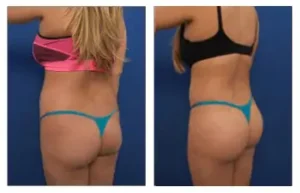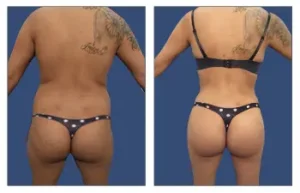Introduction: Liposuction and Fat Transfer
Liposuction and fat transfer go hand in hand. A lot of our patients desire improvements in their legs, buttocks, lateral hips, breasts, face, and hands. For years the standard of care to achieve a patient’s desire to have buttock augmentation was buttock implants. However, with today’s advances in fat grafting technology, we can achieve buttock augmentation with fat transfer.
First, we must discuss the meaning of fat transfer. Fat transfer is a surgical procedure that allows surgeons alike to transfer fat from one area of your body to another. Using liposuction, we extract fat cells from undesirable areas of prominence, process them in sterile containers, and then reinject the purified fat back into the areas needing filling. Essentially, we can fat transfer, also coined as fat grafting, to almost anywhere on your body. As such, liposuction is a critical initial procedure that is required to perform fat transfer.

Most Popular Fat Transfer Procedures
The most popular fat transfer procedure has been to the female buttocks and lateral hips, known as a Brazilian butt lift. This is followed in popularity by fat transfer to the female’s breasts, known as natural breast augmentation, or a male’s chest, known as chest masculinization procedure. Fat grafting can also be done to patients’ facial cheeks and lips to make them fuller and younger in appearance. Most recently, fat grafting to the top of the hand has become a popular procedure to rejuvenate the appearance of appendage.
This procedure has become popular since the appearance of tendons and veins over the top of the hands is a dead giveaway of your age even if you have had a facelift. Fat grafting to the dorsal hand can camouflage these structures by replacing fat that has been lost in this area with aging. Finally, correction of botched liposuction surgeries where concavities or divots have been created can be corrected; an example is an undesirable divot or a shallow groove on an over-suctioned medial thigh.
It is important to understand that liposuction and fat transfer using your fat cells, also known as autografting, is essential to the gold standard body contouring procedures observed today. This is because using your tissue completely disregards any risk of your body rejecting the tissue. In contrast, implants and other foreign objects have a modest risk of being rejected. Essentially, that is why liposuction and fat transfer go hand in hand.
Role of Liposuction for fat transfer
Now, none of this can be achieved without liposuction. It is important to understand that liposuction is more of an art than a surgical procedure. For me, it means treating you like an art masterpiece. I will melt the fat in both the superficial and deep layers and then remove the fat like a sculptor.
I use my non-dominant hand to give you even contours, muscle highlights, and exaggerated curves. Therefore, it is fair to say that liposuction and fat transfer are a two-edged sword. With one edge, we liposuction your undesired areas and give them that fantastic desired look that you dream of, with the other edge we note flat areas that lack volume or that have divots, where we transfer fat to them to create the perfect sculpted you.

Liposuction and Fat Transfer: An Overview of the Procedures
Liposuction is one of the most popular cosmetic surgery procedures, with over 250,000 liposuction procedures performed in the United States in 2020 alone. [1] This body contouring treatment removes unwanted fat deposits from areas like the abdomen, thighs, and back. But did you know the fat collected during liposuction can actually be repurposed? Through a procedure called fat transfer, liposuctioned fat can be injected into other areas of the body for enhancement.
How Does Liposuction Work?
Liposuction slims and reshapes specific areas of the body by surgically removing excess fat cells. A thin tube called a cannula is inserted through tiny incisions in the skin. The dislodged fat cells are then suctioned out as the surgeon moves the cannula back and forth in the treatment area. [2]
Some of the most common sites for liposuction include:
- Abdomen
- Flanks or “love handles”
- Hips and thighs
- Upper arms
- Double chin
The procedure is done under general anesthesia or local anesthesia with sedation. Fat removal is permanent as long as weight is maintained through proper nutrition and fitness.
What is Fat Transfer?
Fat transfer, also referred to as fat grafting, involves taking fat removed via liposuction and reinjecting it elsewhere in the body. Common areas for fat transfer include:
- Breasts – For augmentation or reconstruction
- Buttocks – To create more fullness
- Face – For wrinkle/line filling and contouring
- Hands – To camouflage veins and tendons
The injected fat cells provide natural-looking volume and smoothing effects. Approximately 40-60% of the transferred fat will persist long-term as the body naturally reabsorbs some of it. [3]
How a Fat Transfer Procedure Works
A fat transfer procedure involves three main steps:
- Fat is harvested from one area of the body via liposuction, typically the thighs or abdomen. This is purified to isolate the fat cells.
- The fat cells are prepared and transferred into syringes. This cleans and concentrates them.
- The surgeon meticulously injects the fat cells in small amounts into the desired areas for augmentation or rejuvenation.
Several sessions may be required to achieve optimal results as some of the transferred fat is reabsorbed. Touch-up injections help maintain the volume.
Benefits of Fat Transfer
Some benefits of fat transfer procedures include:
- Completely natural-looking results – it’s your own body fat!
- Minimal risks of allergic reactions or rejection
- Permanent yet reversible and customizable
- No implants or foreign materials required
- Reduces unwanted fat in one area while enhancing another
- Smooths fine lines, wrinkles, and depressed scars
- Youthful, refreshed facial features
Fat grafting provides a “two birds with one stone” approach to both body contouring and facial rejuvenation or enhancement.
Ideal Candidates for Liposuction and Fat Transfer
Good candidates for fat transfer procedures include:
- Those with ample fat deposits suited for transfer
- People looking for moderate enhancement or filling
- Patients who want extremely natural-looking results
- Those seeking youthful facial rejuvenation and volume
- Individuals who do not wish to use artificial implants
- Patients with small breasts, buttocks, hands, etc.
Having realistic expectations of fat grafting outcomes and procedures involved is important to ensure satisfaction.
Recovery After Fat Transfer Procedures
- bruising and swelling for up to 2 weeks
- avoid strenuous activity for 2 weeks post-op
- compression garments for 2-6 weeks to facilitate healing
- work/sedentary activities may be resumed after one week
- results visible after several weeks as swelling resolves
- transferred fat reabsorbs by approximately 40% so touch-ups may be needed
Follow all post-op care instructions from your plastic surgeon to maximize results.
Risks and Limitations
Some risks and limitations of fat transfer include:
- Partial reabsorption of some of the injected fat over time
- Possibility of uneven contours or fat necrosis
- Bruising, swelling, numbness, and pain after procedures
- Infection risk if not performed properly in sterile conditions
- Not suitable for large-volume enhancements or lifts
- May require multiple procedures to attain desired results
Choosing an experienced, board-certified plastic surgeon who specializes in fat grafting techniques helps minimize the risks of complications.
Cost of Fat Transfer Procedures
According to the American Society of Plastic Surgeons, the average cost of fat grafting procedures is: [4]
- Fat grafting to the face – $1,912
- Fat grafting to the breasts – $3,719
- Fat grafting to the buttocks – $4,693
Since it is cosmetic in nature, fat transfer is not typically covered by insurance. Many surgeons offer payment plans or financing to help patients budget accordingly.
Choosing an expert fat transfer surgeon
That is why it is important to seek advice from an experienced surgeon who is an artist. The power of fat grafting is enormous; for example, you may be able to avoid a breast lift with a transfer of fat to your upper breast poles to fill them. With a fat transfer, you can avoid a huge surgical cost and more importantly scars following a surgical incision.
Additionally, you might worry that you might not have enough fat to complete a successful transfer. This is typically not the case, because of VASER liposuction technology. Using VASER technology I can collect 40 to 50% more fat than other surgeons. This is because VASER allows me to go after both the superficial fat and deep fat, while conventional liposuction only targets the deep layers.
Choosing a board-certified cosmetic or plastic surgeon who specializes in body contouring and fat grafting procedures is vital for achieving beautiful, natural-looking results. Be sure to evaluate their:
- Training and years of experience with fat transfer specifically
- Membership in the American Society of Plastic Surgeons (ASPS) or American Academy of Cosmetic Surgery
- Credentialing with the American Board of Plastic Surgery (ABPS)
- Results from past fat grafting patients through photos and reviews
- Facility accreditation status
Conclusion: Liposuction and Fat Transfer
In summary, it is important to understand that liposuction and fat transfer will allow you to achieve a High-definition outcome, what we refer to as a near-perfect 9 or 10 on our high-definition liposuction body scale. This is because the two go hand in hand as a double-edged sword, two different procedures that allow for the same outstanding desired body that you have always dreamed of.
Liposuction can remove unwanted fat from various body zones. Fat transfer then utilizes this fat for augmentation and rejuvenation of the face, breasts, buttocks, or hands. It provides extremely natural-looking results. Though some of the transferred fat is reabsorbed, a youthful enhancement can be attained when performed by a skilled surgeon. Combining liposuction and fat grafting allows you to reshape your body while putting the removed fat to good use!
References:
[1] American Society of Plastic Surgeons. 2020 Plastic Surgery Statistics Report. Accessed Nov 15, 2022. https://www.plasticsurgery.org/documents/News/Statistics/2020/plastic-surgery-statistics-full-report-2020.pdf
[2] American Society of Plastic Surgeons. Liposuction Procedure Information. Accessed Nov 15, 2022. https://www.plasticsurgery.org/cosmetic-procedures/liposuction
[3] Fat Transfer, Breast Augmentation. American Society of Plastic Surgeons, March 2021. https://www.plasticsurgery.org/cosmetic-procedures/fat-transfer-breast-augmentation
[4] American Society of Plastic Surgeons. Buttock Enhancement. Accessed Nov 15, 2022. https://www.plasticsurgery.org/cosmetic-procedures/buttock-enhancement

